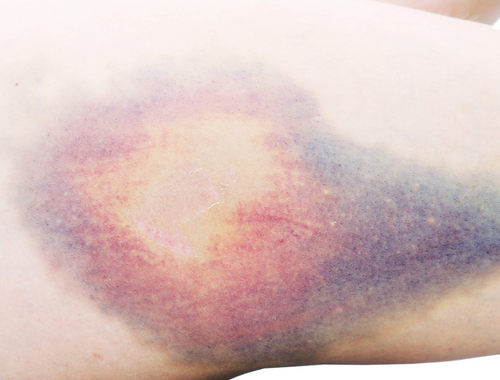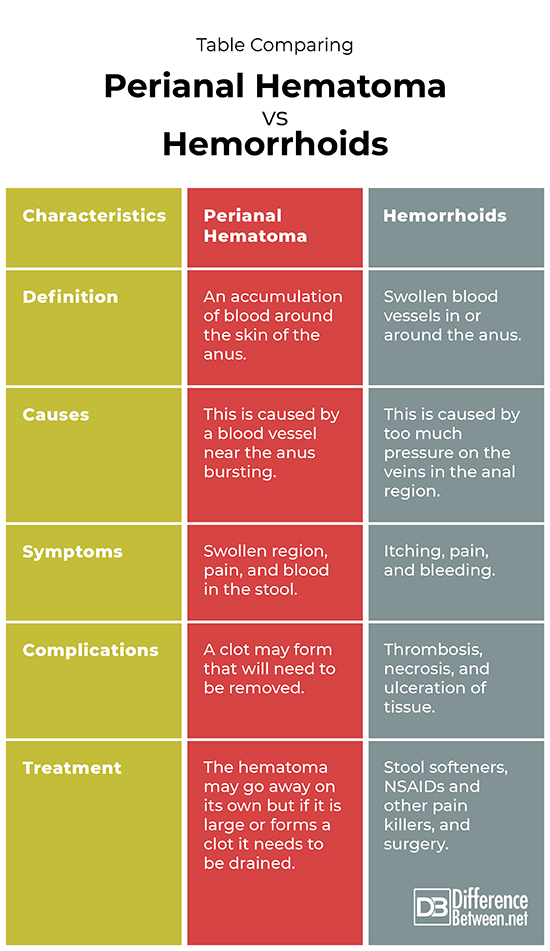Difference Between Perianal Hematoma and Hemorrhoids
A perianal hematoma is an accumulation of blood beneath the skin around the anus. Hemorrhoids are swollen veins around or in the anal canal.

What is Perianal hematoma?
Definition:
A perianal hematoma can be defined as the condition in which blood collects around the anus.
Causes:
A perianal hematoma happens when a blood vessel bursts near the anus. Causes of a perianal hematoma include anything that places pressure on the veins leading to rupture. Lifting heavy objects, coughing, pregnancy, and straining during bowel movements can cause this problem. It can sometimes happen as a result of a colonoscopy or sigmoidoscopy. In very rare cases, a ruptured aortic aneurysm can cause a perianal hematoma.
Symptoms and complications:
The signs of a perianal hematoma include swelling of the skin near the anus. There is also blood in the stool and the person feels pain. The complication of a perianal hematoma is the formation of a large blood clot in the area.
Diagnosis:
Diagnosis is done by visual inspection of the area. No special imaging tools are needed because unlike hemorrhoids, a perianal hematoma is always on the outside of the anus.
Treatment:
There is normally no need for any type of treatment unless the blood pool is large, causing pain, and a clot is formed. In those cases, a doctor can drain the blood from the area.

What are Hemorrhoids?
Definition:
Hemorrhoids are swollen blood vessels that occur in and around the anus. They can be found on the outside or inside the anal canal.
Causes:
Hemorrhoids happen when there is too much pressure placed on the veins in the anal region. This is often caused by straining when people are having a bowel movement. It can also happen in people who are pregnant and those who lift heavy objects.
Symptoms and complications:
The main symptom of hemorrhoids is itching, pain, and bleeding in the anal area. There can be complications if the blood vessels become thrombosed. Tissue can start to die in the area causing necrosis and ulcers.
Diagnosis:
Diagnosis of external hemorrhoids is easily done by visual inspection but internal hemorrhoids are diagnosed during procedures like an anoscopy or colonoscopy. Injection sclerotherapy can be done and surgery may be needed for external hemorrhoids if they have thrombosed. Injection sclerotherapy is when the doctor injects a special substance into a vein causing it to collapse.
Treatment:
Medicine to soften the stool and painkillers including nonsteroidal anti-inflammatory drugs can be given if the hemorrhoids are painful. Preventing constipation and being careful when lifting heavy objects is also a good idea.
Difference between Perianal hematoma and Hemorrhoids?
Definition
A perianal hematoma is when there is an accumulation of blood under the skin and around the anus. A hemorrhoid is when there a swollen blood vessel in or around the anus.
Causes
The cause of a perianal hematoma is a blood vessel bursting. The cause of hemorrhoids is increased pressure on the anal veins.
Symptoms
The symptoms of a perianal hematoma include swelling, pain, and blood in the stool. Symptoms of hemorrhoids are pain, itching, and bleeding.
Complications
A clot can form as a complication of a perianal hematoma. In the case of hemorrhoids, complications include necrosis and ulceration of a thrombosed vessel.
Treatment
A perianal hematoma may go away on its own but if it is large or forms a clot it needs to be drained. Hemorrhoids can be treated with stool softeners, or painkillers, or be surgically removed.
Table comparing Perianal hematoma and Hemorrhoids

Summary of Perianal hematoma Vs. Hemorrhoids
- A perianal hematoma and hemorrhoids can both be painful conditions.
- Both hemorrhoids and a perianal hematoma concern a problem related to blood vessels in the anal area.
- A perianal hematoma often resolves on its own.
- Hemorrhoids are common and sometimes surgery is needed.
FAQ
What happens if a perianal hematoma is left untreated?
Usually, a perianal hematoma is not something to worry about and doesn’t need treatment. If you are worried you can see what your doctor says. It is only when a hematoma is large and very painful that intervention becomes necessary.
How do you get rid of a perianal hematoma?
The hematoma usually goes away on its own. If it is very big you may need a doctor to drain the blood.
What gets mistaken for hemorrhoids?
Some conditions can be mistaken for hemorrhoids. Colon or rectal cancer can cause bleeding. A polyp that can become cancerous can also be assumed to be a hemorrhoid.
How do I know if it’s a hemorrhoid or something else?
The symptoms of itching, pain, and bleeding in the anal area can mean you have a hemorrhoid but you should always check with your doctor to rule out more serious conditions.
Is perianal hematoma a hemorrhoid?
A perianal hematoma is not a hemorrhoid but can occur as a result of a hemorrhoid bursting.
How long does it take for a perianal hematoma to go away?
A small perianal hematoma should go away on its own in about a week.
- Difference Between Rumination and Regurgitation - June 13, 2024
- Difference Between Pyelectasis and Hydronephrosis - June 4, 2024
- Difference Between Cellulitis and Erysipelas - June 1, 2024
Search DifferenceBetween.net :
Leave a Response
References :
[0]Answari, Parswa. “Hemorrhoids (Piles)”. Merckmanuals. Merck & Co., 2022, https://www.msdmanuals.com/professional/gastrointestinal-disorders/anorectal-disorders/hemorrhoids
[1]Lohsiriwat, Varut. "Treatment of hemorrhoids: A coloproctologist’s view." World Journal of Gastroenterology: WJG 21.31 (2015): 9245.
[2]Tamvakopoulos, Spiros K., William P. Corvese, and Lester L. Vargas. "Perianal hematoma—a sign of leakage after rupture of aortic aneurysm." New England Journal of Medicine 280.10 (1969): 548-549.
